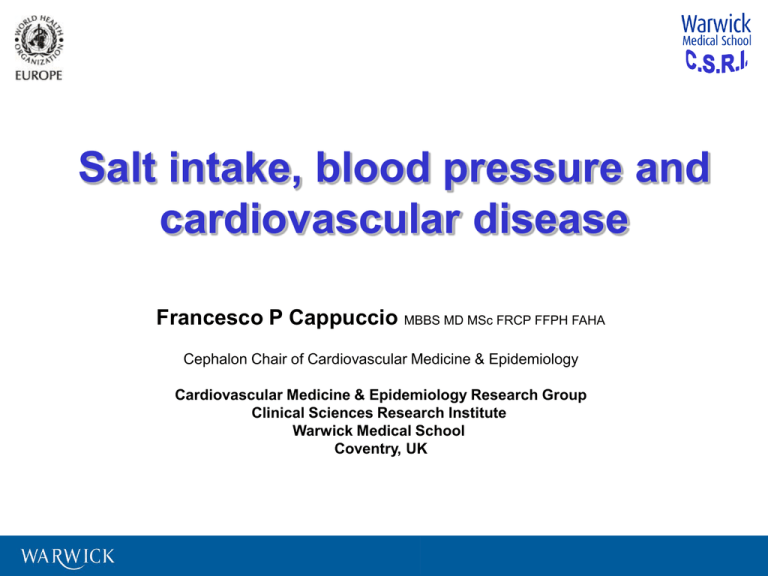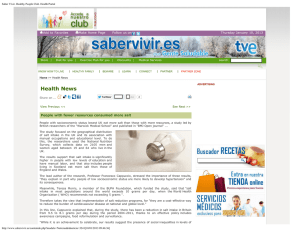Salt intake, blood pressure and cardiovascular disease Francesco P Cappuccio
advertisement

Salt intake, blood pressure and cardiovascular disease Francesco P Cappuccio MBBS MD MSc FRCP FFPH FAHA Cephalon Chair of Cardiovascular Medicine & Epidemiology Cardiovascular Medicine & Epidemiology Research Group Clinical Sciences Research Institute Warwick Medical School Coventry, UK 17 Stroke and Ischemic Heart Disease (IHD) Mortality Rate in Each Decade of Age, Versus Usual Systolic BP at the Start of that Decade IHD Stroke Age at risk 256 80–89 y 128 70–79 y Mortality* 64 256 80–89 y 128 70–79 y 64 60–69 y 32 50–59 y 16 40–49 y 60–69 y 32 50–59 y 16 8 8 4 4 2 2 1 1 0 120 140 160 180 Usual SBP (mmHg) Age at risk 0 120 140 160 180 Usual SBP (mmHg) Lewington et al. Lancet 2002;360:1903–13 “More than a quarter of the world’s adult population – totalling nearly one billion (640 million in developing countries) – had hypertension in 2,000, and … this proportion will increase to 29% - 1.56 billion – by 2,025.” Kearney PM et al. Lancet 2005;365:217-23 The prevalence of hypertension is declining but the incidence of hypertension is increasing “Residual lifetime risk of developing hypertension (lifetime cumulative incidence) is 90%”. “Although the risk of substantially elevated blood pressure is declining, there is still a high risk of developing hypertension”. Vasan R et al. JAMA 2002;287:1003-10 Salt, blood pressure and CVD • Animal studies • Ecological studies • Observational studies – Cross-sectional – Prospective • Intervention studies – RCTs – Community trials Associations between salt intake and CVD risk INTERSALT. Br Med J 1988; 297: 319-28 Perry IJ & Beevers DG J Hum Hypert 1992; 6: 23-5 Schmieder RE et al Circulation 1988;78: 951-6 Dietary Sodium Reduction and Blood Pressure 17 trials in hypertensives (n=734) 11 trials in normotensives (n=2,220) >4 wks duration Reduction in sodium ~80 mmol/day (~4.6 g salt per day) -5.0 mmHg Pooled effects: Systolic -4.96 mmHg (-5.75 to -4.17) Diastolic -2.73 mmHg (-3.21 to -2.25) -2.0 mmHg He FJ & MacGregor GA. J Hum Hypert 2002;16:761-70 Dose-response relationship between sodium intake and blood pressure He FJ & MacGregor GA. Hypertension 2003;42:1093-9 N=1,520 Median f-up 7.93 yrs 669 new cases of HPT RR 1.26 (1.01-1.57) RR 2.43 (1.72-3.22) for High BP-High Na vs Low BP-Low Na Chien K-l et al. J Hypertens 2008;26:1750-6 Predicted reductions in deaths from stroke and IHD with reductions in salt intake in Europe Reduction in daily salt (sodium) intake 3 g/d (50 mmol/d) 6 g/d (100 mmol/d) 9 g/d (150 mmol/d) SBP DBP SBP DBP SBP DBP Average fall in BP (mmHg) 2.5 1.4 5.0 2.8 7.5 4.2 Reduction in stroke death (%) 12 14 23 25 32 36 Stroke deaths prevented in Europe per year 39,698 46,314 76,088 82,704 105,861 119,094 Reduction in IHD death (%) 9 10 16 19 23 27 116,509 136,771 IHD deaths prevented in Europe per year 45,590 50,656 81,050 96,247 Modified from He FJ & MacGregor GA. Hypertension 2003;42:1093-9 Long-term effects of dietary sodium reduction on CVD outcomes TOHP I and II combined RR: 0.70 (0.53-0.94) p=0.018 RR: 0.48 (0.25-0.92) p=0.027 UNa 44 mmol/day reduction over 18 mo N=744 RR: 0.79 (0.57-1.09) p=0.16 UNa 33 mmol/day reduction over 36-48 mo N=2,382 Cook NR et al. Br Med J 2007;334:885-8 Success stories : Finland Mortality 2.5 Hazard ratios* 2.0 1.5 1.0 0.5 CHD CVD All for a 100 mmol/d (~6g salt per day) change in sodium, adjusted for age, year, smoking, cholesterol, HDL-C, SBP, BMI Tuomilehto J et al. Lancet 2001; 357: 848-51 Effectiveness and costs • Highly cost-effective in every setting – Population decrease in salt consumption will increase life expectancy and save costs. • Legislated or voluntary • Most data regional but could easily be contextualized • Robust to sensitivity analyses Selmer R, et al. JECH 2000; 54 :697-702. Murray C et al. Lancet 2003; 361: 717-25. Dietary salt and the cycle of profit SALT Profit Producers (40% by value) Food industry Salt addiction Highly salted processed food (often > seawater) 80% of intake High Salt Profit High Salt Mineral water Soft drinks OBESITY Profit Water binding High Salt Thirst Demand for salty foods Meat products Weight no cost Profit In England and Wales … levels of salt intake are still far from the government’s recommended 6 g of salt per day. Future options are to do nothing, to establish voluntary target levels of salt for a wide range of foods, or to legislate so that the food industry has to comply. Given the inertia of the past 20 years, the first option would not contribute to progress. The “voluntary” option would support existing work, but it is unlikely to achieve the set targets. … The “legislation” option would require the food industry to reduce the salt content of processed food to within set levels. The experience in Finland suggests that legislation has added value to the previous option and at this stage is necessary and justified. e.g. creating incentives rather than disincentives Cappuccio FP. BMJ 2007;334:859-60 W.H.O. recent positions To reduce the average salt consumption of the adult population to <5g/day 2007 2008 Policies for salt iodization and reduction of salt intake are compatible, costeffective and of public health benefit Reliance on salt as a vehicle for the delivery of iodine should not justify promotion of salt intake to the public Additional vehicles to salt for micronutrient fortification should be explored Be lg iu m Ic 2 ela nd U De K 1 nm ar k UK Be 2 Ne l giu th m er 1 l Fi and nl an s d Ru 2 G s er si a m an y2 UK 3 Ita ly 4 G Ma er l t m a an y1 Ita ly 2 I G tal er y 3 m a Fi ny 3 nl an Sp d 1 ai n Sp 1 ai n 2 Ita Po l y 1 rtu Po ga la l n Hu d 2 ng Po ary la nd 1 Task ahead! Salt consumption in Europe in 1985-1987 Grams per day 16 14 12 10 8 6 4 2 0 Intersalt, BMJ 1988 European Salt Action Network Conclusions • Strong ‘causal’ evidence of the link between excessive salt consumption and cardiovascular disease • High ‘attributable risk reduction’ • Population-wide salt reduction highly cost-effective • Urgency to implement strategies, policies and programmes to reduce dietary salt intake • Alternative vehicles to salt for micronutrient fortification • Interaction with food manufacturers (local, national, multinational) • Voluntary vs legislative




